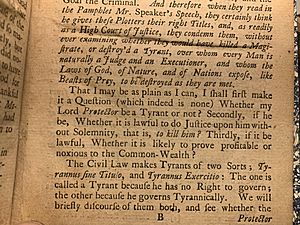Killing No Murder facts for kids
Killing No Murder was a special booklet, called a pamphlet, that came out in 1657. This was during a time in English history known as The Protectorate, which was part of the Interregnum period. The pamphlet suggested that Oliver Cromwell, who was then the leader of England, should be removed from power.
Many people wanted to read this pamphlet when it was first shared. It is said that Oliver Cromwell was so worried after it was published that he never stayed in the same place for more than two nights. He also took great care when he traveled to stay safe.
Contents
What is Killing No Murder About?
This important pamphlet asks three big questions to make its point clear:
- What is a tyrant?
- Is it honorable to remove a tyrant?
- Will removing a tyrant help the country?
The people who wrote the pamphlet used ideas from famous thinkers and writers from history, like Aristotle, Plato, Plutarch, Xenophon, and Cicero. They also used ideas from people living in their own time, like Hugo Grotius. They did this to argue that removing a tyrant has always been seen as an honorable thing to do.
The document describes 14 ways to spot a tyrant. Here are some of the most important ones:
- Military Background: Tyrants often used to be military leaders, like captains or generals. This made people trust them with important matters of the country.
- Clever Tricks, Not Just Force: Most tyrants get their power by being clever and manipulating people, rather than just using military force.
- Silencing Smart People: Tyrants often try to make good, smart people or important groups look bad. They also try to stop people from thinking deeply or getting involved in how the country is run.
- No Group Decisions: Tyrants usually don't allow groups to meet, discuss, or make decisions together.
- Using War for Distraction: They might increase military actions to distract people, get more soldiers, or open up new ways to do business.
- Only Liking What Helps Them: Tyrants only approve of ideas or people if they are useful to them or praise them. For example, they might only like religious ideas if they make the tyrant look good.
- Claiming God's Support: They often pretend that God is guiding them or that they are inspired by God.
- Pretending to Be Religious: They might act like they love God and religion, even if they don't.
- Keeping People Poor: Tyrants might keep people poor or the country unstable. This makes it harder for people to stand up for themselves.
The pamphlet quotes Hugo Grotius, a famous thinker, saying: "A ruler who takes control by force and keeps it only by force is like an enemy to everyone. So, anything you can do against an open enemy, you can do against him. And every person has the right to remove such an enemy."
Another key idea in the pamphlet is that a tyrant doesn't follow any laws. Because of this, a tyrant is not really part of the country's legal system. They are seen as being outside or above the law. Therefore, the pamphlet argues, a tyrant should not get the protections that laws offer, since they don't follow any laws themselves. The pamphlet states, "Someone who avoids justice in the courts should expect justice in the streets."
Who Might Have Written It?
Killing No Murder was published using a fake name, 'William Allen'. However, most people believe it was written by one of three individuals, or perhaps a mix of them. These people are: Colonel Silius Titus, Edward Sexby, or William Allen.
Silius Titus
Colonel Titus was a politician. He was one of two people who said they wrote the pamphlet. Titus's claim made sense because the document has a very sarcastic tone, which was a known trait of his. People sometimes said he didn't take things seriously. Titus would reply that things weren't serious just because they were boring. This sarcastic style can be seen throughout the pamphlet, which is why many thought he wrote it even before he admitted it. Also, Charles II of England, who later became king, gave Titus a special job called Gentleman of the Bedchamber because he wrote the work.
Edward Sexby
Edward Sexby came back to England to try to carry out the ideas from Killing No Murder, after another person, Miles Sindercombe, had failed. After he didn't succeed, Sexby was caught trying to escape to Amsterdam. He was then put in the Tower of London. While in prison, Sexby became very unwell mentally and died a year later in 1658. Before he passed away, he was pressured by Sir John Barkstead to admit that he helped write the pamphlet.
William Allen
Even though many thought 'William Allen' was just a fake name, another idea was that a real person named William Allen wrote the document. This William Allen was a former soldier in the New Model Army and a Republican. He had connections with Edward Sexby and Thomas Sheppard. This group (Allen, Sexby, and Sheppard) had caused trouble for Cromwell before by sharing their worries about the army's feelings toward Parliament. So, it's possible that Allen bravely wrote the document himself before he died. However, it's also possible he was named as the author by one of the other two writers to get back at him.




